The three main types of fishing lines are monofilament, braid, and fluorocarbon. There are also fishing leader lines made out of monofilament, fluorocarbon, single strand wire, and multi-strand cable. The color of the fishing line can also be important to be less visible to the fish or more visible to the angler above water.
Lead core, Monel, copper, and stainless steel wire lines allow lines to sink deeper into the water when trolling with lures and spoons. There are four types of fishing lines used for fly fishing which include a backing line, floating line, tapered leader, and tippet. When ice fishing there is a specially designed braid to reduce ice buildup on the line.
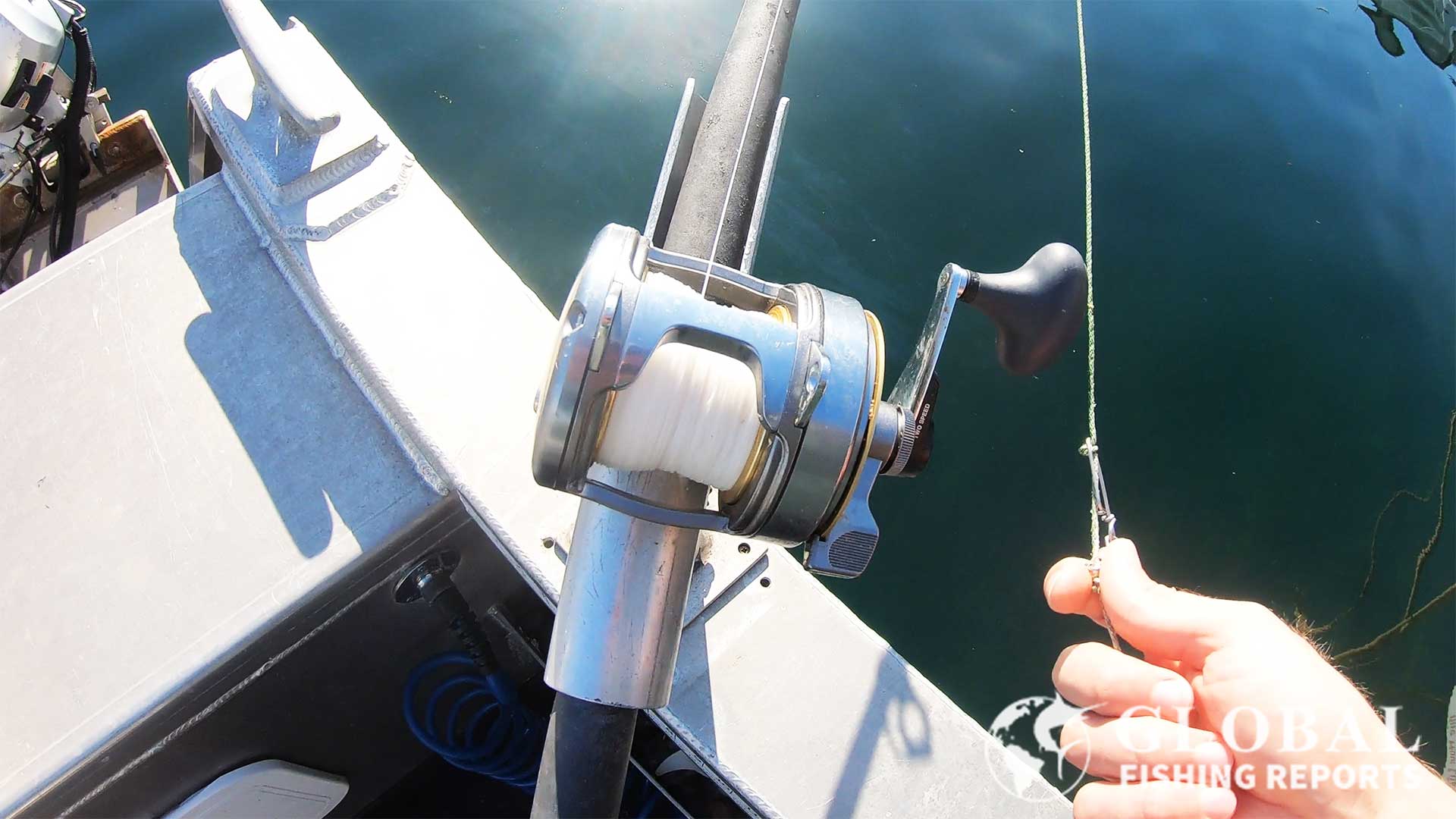
Summary of Fishing Line Types
Braided Line: Ultra-thin, strong lines with no stretch, offering superior sensitivity, casting distance, and line capacity on reels.
Metered Braided Line: Color-changing braided lines that mark depth increments, providing a visual reference for precisely controlling trolling depths and distances.
Monofilament Line: Single-strand nylon lines with good stretch and versatility, ideal for many fishing situations from freshwater trout to offshore trolling.
High Visibility Line: Brightly colored lines designed for maximum visibility above water, helping anglers detect subtle bites and prevent tangles when running multiple lines.
Fluorocarbon Fishing Line: Low-visibility mainline that sinks faster than mono and is more transparent underwater. This is best used in a lighter-pound test as it gets stiff with thicker lines.
Fluorocarbon Leader Line: Less visible underwater and has superior abrasion resistance, perfect for leader applications with leader-shy fish.
Multi-strand Cable Leader Line: Flexible steel cables resistant to kinking, primarily used for shark fishing and trolling for toothy species.
Single-strand Wire Leader Line: Thin, strong steel leaders that provide protection against sharp-toothed predators while maintaining better visibility than cable.
Fly Fishing Line: Braided backing line, floating line, tapered leader followed by a a tippet line.
Lead Core Line: Dense, sinking lines with a lead wire center and colored metering system that allows precise depth control when trolling without downriggers.
Monel Line: Premium nickel-copper alloy trolling wire with superior strength, corrosion resistance, and kink resistance for deep water presentations.
Ice Fishing Line: Specialized cold-resistant lines that reduce ice buildup and provide sensitivity in winter conditions.
Braided Fishing Line
Braided fishing line seems to be coming more and more popular. The biggest advantage of braid is that it is thin and light witch allows for far casting with spinning tackle. Since it has a small line diameter fishing reels can hold significantly more line. This allows lighter tackle to be used to catch bigger fish. One of my favorite setups for freshwater fishing is using a 20-pound braided line with a 20-pound fluorocarbon leader. The setup can be cast far and is strong enough to catch pretty much any fish that will bite.
When saltwater fishing I like using a 50-pound braided line on spinning tackle with an appropriately sized leader. This will work great to catch both small and large fish. For trolling reels 80-100 pound braid is a good size. If the line is to thin it can dig into itself. An 80-pound line is strong enough to catch just about every fish in the ocean. It is import to use a reel with quality drag with braid and line that does not stretch to account for sharp increases in force that can happen when fighting large fast fish.
Braided line has virtually zero stretch which makes the line very sensitive to feeling bites. When fishing in deep water or with lines set far behind the boat it also allows for a quick hook set. Braided line does not absorb water which makes the wet and dry knot strength about equal.
1. Power Pro Spectra Best Braided Fishing Line

Buy from Amazon
Shop Bass Pro Shops
| Pound Test |
4, 8, 10, 15, 20, 30, 40, 50, 65, 80, 100, 200, 250 |
| 20lb Diameter |
0.23 mm |
| 20lb Cost Per Yard |
$0.10 |
| Color |
Moss-Green, Hi-Vis Yellow, Multi, White, Red |
| Length in Yards |
150, 300, 500, 1500 |
| Made in |
USA |
Power Pro braid is one of the most widely used fishing lines on the market. This original Power Pro line is made of spectra. Power Pro has several other variations of braid including Maxcuatro which is 25 percent thinner, downrigger line which is a 200-pound braided line, and ice-tec line designed to limit ice build-up while ice fishing.
The braided fishing line is the best line for spinning reels from a 15-pound test to a 100-pound test. This is because braid is lightweight and flexible which allows for far casting. A braided line has virtually zero stretch which makes it the most sensitive at feeling bites and great for quickly getting a strong hook set. The braided line also has about a seven-year shelf life and can last several years on a reel. Another good thing about braid is that it does not absorb water so the knot strength is maintained when the line is wet. It is also very resistant to damage from UV light.
Moss-Green is the most popular braided line color but white is also a great color to use. The white line has good visibility above water and low visibility when the sky is the background. The least visible braid depends on the lighting conditions and color of the water. The video below shows how different colors of braided lines look above and below the water.
Metered Braided Line
Metered braided line has become one of my favorite fishing innovations in recent years. These specialty lines feature alternating colors that change at specific intervals, typically every 25 feet. Some lines even include 5-foot marking bands within each color section. Using a metered line is a great way to estimate the depth of the lures and the distance of the lures behind the boat.
2. Power Pro Depth Hunter Best Braided Metered Line
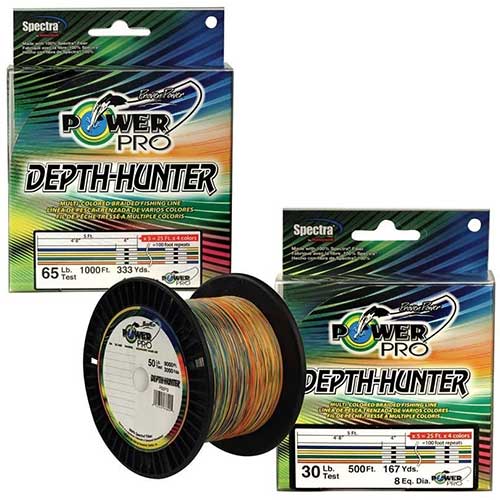
Buy from Amazon
Shop Bass Pro Shops
| Pound Test |
20, 30, 40, 50, 65, 80, 100 |
| 20lb Diameter |
0.23 mm |
| 20lb Cost Per Yard |
$0.09 |
| Color |
Muli-Color |
| Length in Yards |
167, 333, 500, 1500, 3000 |
| Made in |
USA |
Power Pro Depth-Hunter is a braided fishing line that is metered. It is made with alternating blue, yellow, green, and orange colors every 25 feet. This means that every time a color repeats 100 feet of the line has been let out. Within each solid color, there is a black tic every 5 feet to further define the depth of the line.
Many angels never think about the benefits of using a metered line. There are other ways to estimate water depth by pulling arm lengths of line or counting so many seconds. In my opinion, outside of using a line counter reel, a metered line is the best way to estimate line depth. However, a metered line can be used on spinning reels and conventional reels without line counters. The metered line is also a good way to estimate the distance lures are behind the boat. For diving plugs, the amount of line set out determines the depth of the lure.
When using a braided fishing line I see little reason for it not to be a metered line. Braid is almost always used with monofilament or fluorocarbon leader so the color of the braid is not important. It is surprising how useful a metered line can be, especially when jigging deep in the water.
Monofilament Fishing Line
Monofilament fishing line is a great type of fishing line to use to catch many types of fish. For freshwater fishing, a light 4-6 pound monofilament is good for trout, crappie, and panfish fishing. When bass fishing 12-20 pound test works well depending on the weight of the lure. When trolling in freshwater 20-30 pound monofilament line is commonly used on conventional fishing reels.
For saltwater fishing spinning reels a 20-pound monofilament is good for reef fishing and a 30-pound line is good for fishing offshore for small tuna and mahi-mahi. When targeting big game fish with convection reels a 60-80 pound line works well for fish up to around 400 pounds. For huge bluefin tuna and marlin, a 130 class reel and 130-pound monofilament line are best.
When selecting a good monofilament, the desired properties are for the line to have stretch, flexibility, and high knot strength. Most monofilament lines will work on conventional reels but soft thin lines should be used on spinning reels. Also, make sure the monofilament line is not old. These lines break down with age and UV light exposure. An old line will have decreased tensile strength and knot strength. After tying a knot always pull hard on the line to make sure the line is strong.
3. Trilene XL Best Monofilament for Spinning Reels
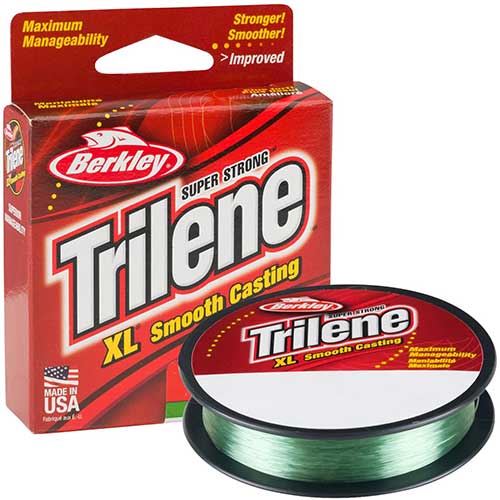
Buy from Amazon
Shop Bass Pro Shops
| Pound Test |
2, 4, 6, 8, 10, 14, 17, 20, 30 |
| 20lb Diameter |
0.40 mm |
| 20lb Cost Per Yard |
$0.026 |
| Color |
Clear, Low-Vis Green, Fluorescent Clear-Blue |
| Length in Yards |
110, 300, 330, 1000, 2600, 3000, 9000 |
| Made in |
USA |
Berkley Trilene XL smooth casting is the best monofilament fishing line for spinning reels. There are several types of Berkley Trilene lines include Big Game, Extra Tough, Fluorocarbon Ice, TransOptic, BigCat, and Sensation. This XL smooth casting is a soft flexible line designed for far casting.
The line is labeled as super strong, maximum manageability. Monofilament line works reasonably well up to about 30 pounds on spinning reels. For line strength above 30 pounds, it is typically best to them switch to a braided line. Fishing with a 20-pound line is strong enough to catch the most freshwater fish. A 30-pound line is strong enough to catch big game fish such as king salmon, tarpon, mahi-mahi, and sailfish.
4. Sufix Superior Best Saltwater Monofilament Fishing Line

Buy from Amazon
Shop Bass Pro Shops
| Pound Test |
6, 8, 10, 12, 15, 20, 25, 30, 40, 50, 60, 80, 100, 130, 150, 200, 250, 300, 400 |
| 20lb Diameter |
0.46 mm |
| 20lb Cost Per Yard |
$0.012 |
| Color |
Clear, Hi-Vis Yellow, Smoke Blue |
| Length in Yards |
110, 275, 1095, 2405, 4810 |
| Made in |
China |
Sufix Superior is the best fishing line for saltwater fishing. The line can be purchased in bulk for a reasonable cost. A 30-pound line is perfect for saltwater spinning reels and a 60-pound line works well on conventional reels that are used for big game trolling.
The line has high stretch and good knot strength. It also is known for being a good 130-pound class fishing line and is made in line strength up to a 400-pound test. Monofilament line does break down from UV light and has a shelf-life of 2-3 years. When fishing with a monofilament line it is always a good idea to test each knot after trying it and change out the line at the first sign of a weakened line.
5. Trilene Big Game Best Freshwater Monofilament Line
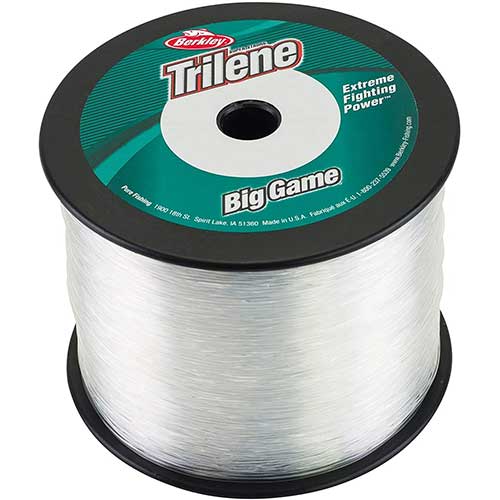
Buy from Amazon
Shop Bass Pro Shops
| Pound Test |
8, 10, 12, 15, 20, 25, 30, 40, 50, 60, 80, 100, 130 |
| 20lb Diameter |
0.45 mm |
| 20lb Cost Per Yard |
$0.010 |
| Color |
Clear, Coastal Brown, Green, Solar Collector, Steel Blue, Ultra Clear |
| Length in Yards |
235, 440, 595, 650, 1175, 1480, 2380, 3270, 5280, 6000, 7140 |
| Made in |
USA |
Berkley Big Game Trilene is the best monofilament fishing line for freshwater fishing. That line is great for conventional fishing reels used for trolling or jigging. Trilene XL smooth casting monofilament is better for baitcasting reels and spinning reels. This monofilament line has an average thickness to strength ratio.
Big Game Trilene is reasonably soft and flexible so it does not get bird nested easily. The line does have memory so it is good to spool the line onto the reel the night before. The line can also be used for saltwater. It is a very reasonably priced line and the 8-pound to 15-pound Big Game Trilene line does work decently on spinning reels. A 20-pound to 60-pound line works well for conventional reels depending on the type of fish being targeted.
6. Stren Clear Blue Fluorescent Best Blacklight Fishing Line

Buy from Amazon
Shop Bass Pro Shops
| Pound Test |
4, 6, 8, 10, 14, 20, 30 |
| 20lb Diameter |
0.45 mm |
| 20lb Cost Per Yard |
$0.035 |
| Color |
Clear, Clear Blue Fluorescent Cast, Hi-Vis Gold, Low-Vis Green |
| Length in Yards |
10, 250, 300, 330, 1000, 2400 |
| Made in |
USA |
Stren clear blue fluorescent is the best fishing line to use with a black light or fluorescent night. The line will reflect the light and become highly visible to the angler. It is the best line for night fishing in my option because the clear blue line is also a good color for daytime fishing. This makes it so the same reels can be used during the day and at night.
There are several other good monofilament lines to fish with under a black light. These include Stren’s High Impact in high visibility green, Berkley Big Game solar collector, and Berkley Trilene Sensation solar. For a braided line, the best type to use with a blacklight is Super8Slick V2 in the moonshine color.
7. Ande Premium Monofilament Pink Fishing Line

Buy from Amazon
Shop Bass Pro Shops
| Pound Test |
2, 4, 5, 8, 10, 12, 15, 20, 25, 30, 40, 50, 60, 80, 100, 200, 300, 400 |
| 20lb Diameter |
0.45 mm |
| 20lb Cost Per Yard |
$0.20 |
| Color |
Premium Pink, Premium Green, Premium Clear |
| Length in Yards |
167, 333, 500, 1500, 3000 |
| Made in |
Germany |
Ande Premium is the best pink monofilament line on the market. The color red and pink disappears at around 20 feet of water depth. For this reason, many anglers use a pink line when bottom fishing and jigging.
Some people might think even though pink disappears a clear line is already clear so why not use that. The reality is that a blue, green, smoke, or pink-tinted line can be less visible depending on the amount of light, water-color, depth of water, and background color. If people in the local area use a certain color line for a certain fish, chances are there is a good reason.
Sometimes fishermen think that because they occasionally catch fish with a certain setup that details such as line color do not matter. Sure I have caught leader shy fish like tuna and snapper with highly visible wire cable. That does not mean that the fish are not typically leader shy. Chances are that day we got lucky with aggressively feeding fish and lighting conditions that made the line visibility less important. There are other days when switching from a 15-pound fluorocarbon leader to a 10-pound leader will make the difference of catching fish or not catching fish.
8. Maxima Ultragreen Monofilament Fishing Line for Salmon
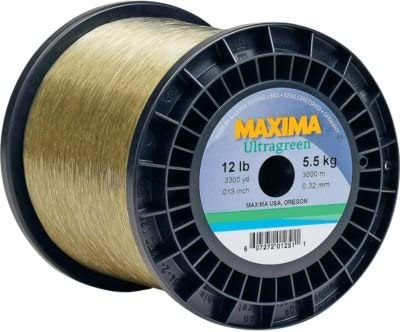
Buy from Amazon
Shop Bass Pro Shops
| Pound Test |
3, 4, 5, 6, 10, 12, 15, 20, 25, 30, 35, 40, 50, 60, 80, 100, 130, 150, 180 |
| 20lb Diameter |
0.43 mm |
| 20lb Cost Per Yard |
$0.041 |
| Color |
Ultragreen |
| Length in Yards |
660, 900, 2000, 2300, 2630, 3300 |
| Made in |
Germany |
Maxima Ultragreen is the best fishing line to use when salmon fishing. This line has a smoke green tint that matches the water-color where salmon are found very well. This line works as a mainline or leader material. For a mainline when salmon trolling 30-pound line is perfect. When making salmon leaders 30-50 pound test is typically used.
If you are not fishing way offshore in clear blue water chances are the water color will be stained green. That makes this a good line choice of line for many types of fish including fluke, striped bass, and bluefish. The line is above average quality monofilament with good knot strength, medium stretch, and average sensitivity.
High Visibility Fishing Line
Bright colored fishing lines are not meant to hide from fish but to be seen by anglers. When running multiple lines while trolling or drift fishing, high-vis lines make it easier to track each line’s position and prevent tangles. They also help detect subtle bites by showing small movements that might otherwise go unnoticed.
For night fishing, special lines that reflect blacklight or UV light glow brightly, solving the challenge of monitoring your line in darkness. Popular colors include yellow, chartreuse, orange, and white for daytime use.
While traditional wisdom suggests keeping lines invisible to fish, when using proper leader material, mainline visibility matters much less than being able to see your line above water. This is why many professional captains prefer high-visibility mainlines paired with appropriate leaders for the target species.
9. Sufix Superior Best High Visibility Fishing Line

Buy from Amazon
Shop Bass Pro Shops
| Pound Test |
6, 8, 10, 12, 15, 20, 25, 30, 40, 50, 60, 80, 100, 130, 150, 200 |
| 20lb Diameter |
0.46 mm |
| 20lb Cost Per Yard |
$0.20 |
| Color |
Clear, Hi-Vis Yellow, Smoke Blue |
| Length in Yards |
670, 1445, 1485 |
| Made in |
China |
Sufix Superior in high visibility yellow is great for seeing the line above the water. This allows anglers to keep track of lines when drift fishing and trolling to prevent lines from crossing and getting tangled. The line comes in 1/4 pound or 1-pound spoons so the length of the line varies based on the strength rating.
There are several good high visibility monofilament line colors on the market including high visibility yellow, pink, solar green, and blaze orange. Braided line colors that are visible above water include high visibility yellow, white, red, neon lime, and orange. Many anglers select a line based on the underwater visibility of the line. However, if a leader line is being used the color of the line above water can actually be more important.
Fluorocarbon Fishing Line
A fluorocarbon fishing line is technically a type of monofilament line. It is made with a fluorocarbon resin material rather than the typical nylon resin for standard monofilament. The fluorocarbon line is denser and has an index of refraction closer to water than a nylon line. The result is that less light is bent and reflected by the line making it less visible under some conditions. The downside of fluorocarbon is that it can be stiff and less flexible. This makes it a bad mainline to use for spinning reels if the line is over a 10-pound test. When the line is under a 10-pound test it is so thin and flexible that it still casts very well.
The more dense fluorocarbon line does not absorb water like nylon monofilament. This allows the line to have higher abrasion resistance and knot strength when wet. A fluorocarbon line also sinks faster than a monofilament line, which helps get lures deeper and maintain better contact with the bottom.
10. Berkley Vanish Best Fluorocarbon Fishing Line

Buy from Amazon
Shop Bass Pro Shops
| Pound Test |
2, 4, 6, 8, 10, 12, 14, 20, 30, 40 |
| 20lb Diameter |
0.40 mm |
| 20lb Cost Per Yard |
$0.062 |
| Color |
Clear, Clear Gold-Transition, Clear Red Transition |
| Length in Yards |
110, 250, 350, 2000 |
| Made in |
USA |
Berkley Vanish is a fluorocarbon fishing line that is used for the entire spool of line, not just the leader. Typically fluorocarbon is a stiff line that is only used for leader material. This line works well on spinning reels if it is under a 10-pound test. Above 10 pound test it works well on conventional fishing reels. Berkley Vanish is the best line to use in a 2-pound to 6-pound test for trout fishing. Trout can be leader shy and this low-visibility line works very well.
Fluorocarbon has several advantages over a standard nylon monofilament. These advantages include being more sensitive, higher wet knot strength, faster sinking, abrasion-resistant, UV resistant, and lower visibility. Fluorocarbon has an index of refraction of 1.42, monofilament is 1.55, and water is 1.33. Since fluorocarbon has an index of refraction closer to water the light passes through it with less bending and reflection. In certain situations, this can make the line less visible. Fluorocarbon is not invisible to fish and using a thinner fluorocarbon line makes the line less visible.
Fluorocarbon Leader Line
Fluorocarbon leader material has several advantages over a standard nylon monofilament. These advantages include being more sensitive, higher wet knot strength, faster sinking, abrasion-resistant, UV resistant, and lower visibility. Fluorocarbon has an index of refraction of 1.42, monofilament is 1.55, and water is 1.33. Since fluorocarbon has an index of refraction closer to water the light passes through it with less bending and reflection. In certain situations, this can make the line less visible.
In most cases, a fluorocarbon line is primarily used as leader material rather than mainline. Remember that fluorocarbon is not invisible to fish and using a thinner fluorocarbon line makes the line less visible. Using a 4-6 pound line is good for crappie and trout. A 20-pound leader is quite strong and is a great size line for a wide range of fish from bass to most types of inshore and reef fish. When targeting large fish 50-100 pound leaders are typically used. Line up to around 80 pounds can be tied with knots rather than crimps.
Fluorocarbon leaders are especially important when fishing for leader-shy fish like bonefish, permit, snapper, and tuna. The line can be damaged from the bill of billfish or the rough mouths of tarpon. Once a billfish is caught the leader line should be changed. The line could be damaged and more often the bill rubbing on the line makes surface scratches on the fluorocarbon leader which makes the line very visible. Anytime fluorocarbon lines get scratched the leader section should be changed.
11. Seaguar Premier Fluorocarbon Leader Line
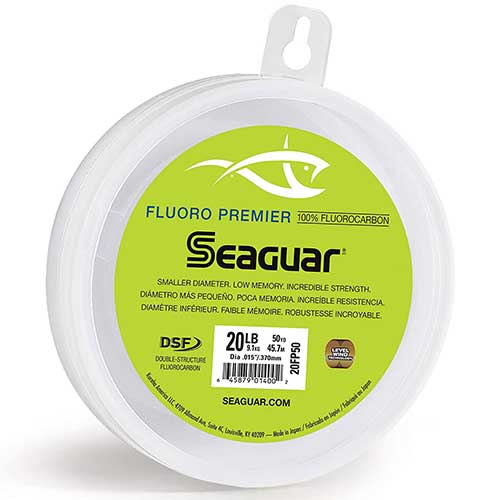
Buy from Amazon
Shop Bass Pro Shops
| Pound Test |
20, 25, 30, 40, 50, 60, 80, 100, 130, 150, 170, 200 |
| 20lb Diameter |
0.370 mm |
| 20lb Cost Per Yard |
$0.45 |
| Color |
Clear |
| Length in Yards |
50 |
| Made in |
Japan |
Seaguar Premier fluorocarbon leader line has a very small diameter to strength ratio. This helps make the leader line less visible for any given strength of the line. The only monofilament or fluorocarbon fishing line that is thinner is the Seaguar Gold fluorocarbon which is offered from 15 pounds to 40 pounds.
Seaguar Fluoro Premier is 100 percent fluorocarbon and is extruded as a double structure fluorocarbon. This is a process that combines two resins. The first resin is for a stiff core that has high strength, low stretch, and high sensitivity. A softer flexible outer layer makes the line more flexible for better action of lures and baits.
12. Seaguar Blue Label Best Big Game Fluorocarbon Leader
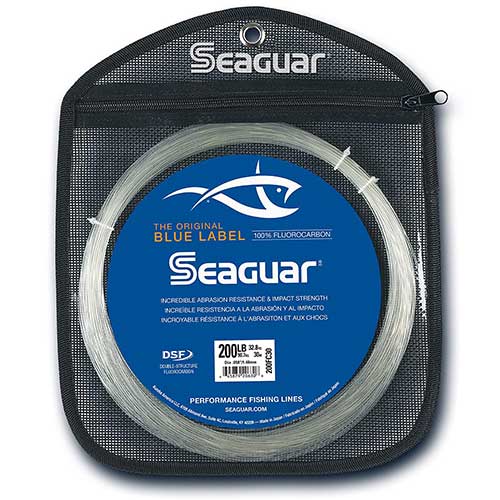
Shop Bass Pro Shops
| Pound Test |
100, 130, 150, 180, 200, 220 |
| 20lb Diameter |
1.48 mm |
| 20lb Cost Per Yard |
$3.58 |
| Color |
Clear |
| Length in Yards |
32.8 |
| Made in |
Japan |
Seaguar Blue Label fluorocarbon is a very popular fluorocarbon leader from a 10-pound test to a 220-pound test. This is the best big game offshore fluorocarbon. It is a 100 percent double structure fluorocarbon. The advantages of this line is low-visibility, high knot strength, abrasion-resistant, and fast sinking.
A heavy abrasion resistant leader line is especially important when fishing for billfish. The bill of the fish rubs on the line and can wear through thin monofilament fishing lines. Once a billfish is caught the leader line should be changed. The line could be damaged and more often the bill rubbing on the line makes surface scratches on the fluorocarbon leader which makes the line very visible. After catching a billfish run the line through your fingers and look closely at the line and you will see what I am talking about. Anytime fluorocarbon lines get scratched the leader section should be changed.
13. Ande Best Monofilament Leader Line
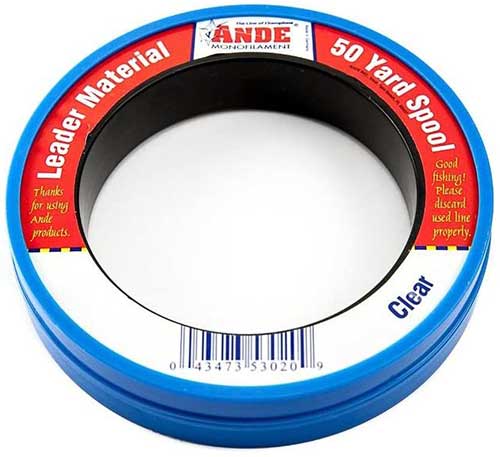
Buy from Amazon
Shop Bass Pro Shops
| Pound Test |
10, 12, 15, 20, 30, 40, 50, 60, 80, 100, 125, 200, 150, 200 |
| 20lb Diameter |
0.45 mm |
| 20lb Cost Per Yard |
$0.15 |
| Color |
Clear, Pink |
| Length in Yards |
50 |
| Made in |
Italy |
Ande makes a great fluorocarbon and monofilament leader material. This monofilament leader is the same line as standard Ande monofilament which is a premium quality medium-soft line. The line is flexible, strong, and has good knot strength.
There is some debate within the fishing community whether a monofilament leader is just as good as a fluorocarbon leader. Some anglers say that fluorocarbons high abrasion resistance and low visibility is largely a marketing tactic to charge really high prices per foot of line. Personally, I think there are advantages of fluorocarbon but they are not as significant as some people think.
Monofilament line absorbs water and the knot strength and abrasion resistance can decrease when then the line is wet. Often times people test the dry monofilament line strength. A fluorocarbon line is not invisible underwater but can reflect less light which can be an advantage.
In some cases, a monofilament leader will work just as well as a fluorocarbon leader. Other times when fishing for leader shy fish like tuna or snapper a small fluorocarbon line can be the difference between getting bites and not getting bites. If cost is a factor and you are skeptical of the advantage of fluorocarbon Ande monofilament would be a great leader material to use. Using some type of monofilament or fluorocarbon leader is definitely a good idea when fishing with a braided line.
14. Jinkai Best Big Game Monofilament Leader Line
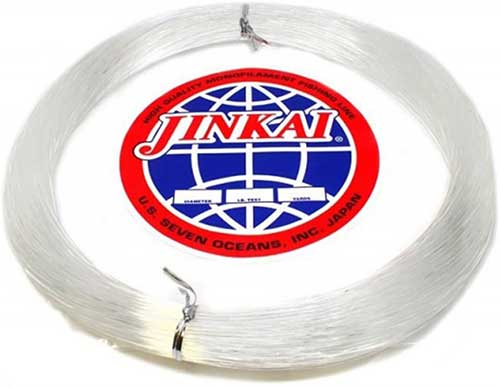
Buy from Amazon
| Pound Test |
50, 60, 80, 100, 130, 150, 175 220, 200, 250, 300, 400, 500, 600 |
| 20lb Diameter |
0.23 mm |
| 20lb Cost Per Yard |
$0.10 |
| Color |
Clear, Smoke Blue |
| Length in Yards |
50 or 100 |
| Made in |
Japan |
Jinkai is a big game monofilament that is soft and has high stretch. It is made with a proprietary process that extrudes multiple nylon resins to create a soft-core and hard abrasion-resistant outer layer. The line comes in 50 or 100-yard leader coils in a mesh storage bag. This line can be used in a 20-foot section of a 400-pound test for a wahoo shock leader or a 100-foot section of a 250-pound test for a swordfish leader.
Jinkai line is used by both commercial and recreational fishermen. This big game monofilament is a popular choice when targeting a wide range of fish species including halibut, tuna, marlin, swordfish, and amberjacks.
15. Trilene Fluorocarbon Best Ice Fishing Line
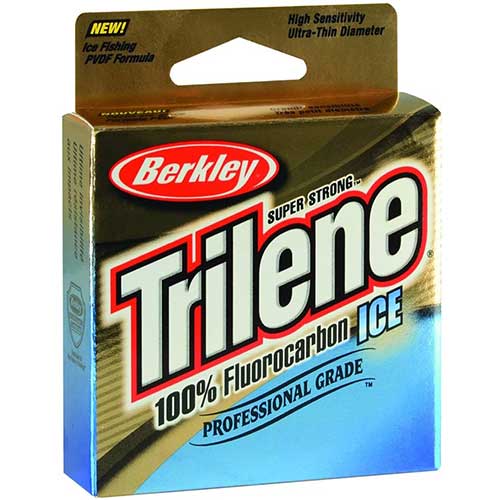
Buy from Amazon
Shop Bass Pro Shops
| Pound Test |
2, 3, 4, 5, 6 |
| 20lb Diameter |
0.25 mm |
| 20lb Cost Per Yard |
$0.11 |
| Color |
Clear |
| Length in Yards |
75 |
| Made in |
USA |
Trilene Fluorocarbon Ice is the best ice fishing line. When ice fishing it is important to have a fishing line that resists ice build-up. Ice can build on the line near the water or on the reel. A fluorocarbon line is better than standard monofilament because it does not absorb water. There are braided lines that are made to shed water but when not fishing in a headed tent the fluorocarbon line is best at limiting ice formation.
Another advantage of the fluorocarbon line is its low visibility. When ice is covering the lake the water becomes very clear so a clear leader is important. The thinner the line the less visible it will be to the fish. For reason, it is common to use a 2-pound to 6-pound test line when ice fishing. Fish are cold-blooded which makes them lethargic. In cold water, fish will not fight nearly as hard as they do in the spring, summer, or fall. Also, the fish do not feed as often so having good-looking bait is important.
Ice fishing line
An ice fishing line is a thin light line that is less likely to build up ice and freeze. A light 2-6 pound line test is typically used for ice fishing. Trilene Fluorocarbon Ice is a good line option because the fluorocarbon line does not absorb water like monofilament. Sufix 832 braid is another good line choice at it is made with a gore fiber that is hydrophobic and repels water. This helps to reduce the amount of ice build-up on the line. In extremely cold conditions the fluorocarbon line is the better option cause it will have less ice build-up. Also, the fluorocarbon line is already low visibility without adding a leader.
16. Sufix 832 Best Braided Ice Fishing Line

Buy from Amazon
Shop Bass Pro Shops
| Pound Test |
4, 6, 8, 10, 20, 30 |
| 20lb Diameter |
0.23 mm |
| 20lb Cost Per Yard |
$0.34 |
| Color |
Ghost, Neon Lime, Camo |
| Length in Yards |
50 |
| Made in |
Taiwan |
Sufix 832 braid is the best ice fishing braid. It has Gore performance fibers that are hydrophobic and repel water. This helps reduce the amount of ice build-up on the line and reel. The line is made with 8 fiber strands, 7 are Dyneema fibers and 1 is Gore performance Fibers.
Sufix 832 Advanced Superline is also a great braid for warm water fishing as well. It is made with a dense 32 weaves per inch which makes it a smooth and round line. Standard color options are ghosts and low visibility green. Sufix 832 Ice Braid comes in 20-pound and 30-pound options which are good when targeting big fish through the ice.
Multi-strand Cable Leader Line
Multistrand cable is used for shark rigs and trilling cable for catching wahoo. The cable is flexible and easy to wrap up and store. Common cable types are 7-strand or 49-strand and can be a bare cable or have a nylon coating. A multi-strand cable is thicker than single-strand wire but is nice because the line does not get kinked as easy. Crimps are needed to make the swivel and hook connections. The cable can not be twisted or tied.
17. AFW Best Multi-Strand Cable Steel Leader Line

Buy from Amazon
Shop Bass Pro Shops
| Pound Test |
20, 30, 45, 60, 90, 135, 170, 210, 200, 250, 325 |
| 20lb Diameter |
0.28 mm |
| 20lb Cost Per Yard |
$0.19 |
| Color |
Bright, Camo Brown |
| Length in Yards |
10, 100, 200, 333 |
| Made in |
USA |
AFW SurfStrand is the best multi-strand cable. Color options are bright and camo brown. This same cable comes as Surflon which is a stainless steel cable that is coated with either a black or clear nylon later. The nylon should be cut from the ends before adding crimps to Surflon.
The multi-strand cable is one wire made from 7 individual strands. The result is a flexible cable that is also strong. When using multi-strand it must be connected to the hooks and swivel using crimps. The cable can not be twisted or tied.
A multi-strand cable is great when shark fishing and also works to catch barracuda, kingfish, wahoo, and other fish with sharp teeth. Single strand wire is a bit thinner for a given line strength and is another option. The advantage of multistrand wire is that it is flexible and less susceptible to getting kinks.
Single Strand Wire Leader Line
Single strand wire is the most popular leader to catch fish with sharp teeth. This is because the wire is low-cost and easy to make leaders without having crimps. The wire is thin and less visible to fish than multi-strand cable in most cases. Thin number 4 38 pound test wire can catch small spanish-mackerel, large kingfish, and even mahi-mahi. Large #10 124 pound wire is a great leader for both large and small sharks.
The color of the wire is not particularly important as most fish being targeted with wire are not leader shy. However, occasionally you will catch leader shy fish like tuna and snapper with wire so it is good to use a thin wire that matches the environment. Bright stainless steel is good for clear water and bright days. Camo-brown is better for stained green water and low light conditions.
18. AFW Best Single Strand Wire Steel Leader Line
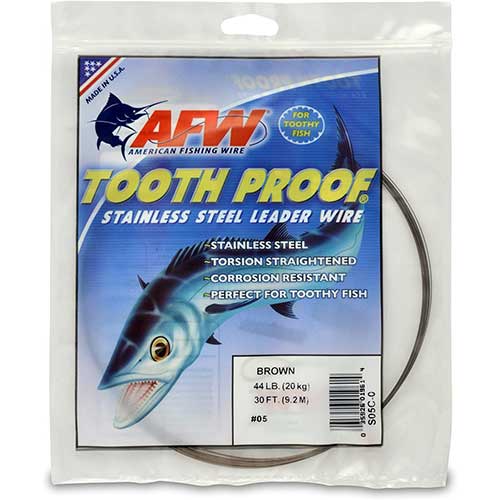
Buy from Amazon
Shop Bass Pro Shops
| Pound Test |
#2 27, #3 32, #4 38, #7 69, #9 105, #10 124, #11 140, #12 176, #19 360 |
| 27lb Diameter |
0.28 mm |
| 27lb Cost Per Yard |
$0.07 |
| Color |
Bright, Camo Brown. |
| Length in Yards |
10, 53, 100, 383 730, 1025 |
| Made in |
USA |
AFW Tooth Proof stainless steel leader wire is made of single-strand wire. Color options are bright stainless steel or camo brown. The wire is sized from number 2 a 27-pound test wire to number 19 which is a 360-pound test wire.
There are really only three-wire sizes that are needed to catch most fish. A number 4 38 pound test wire is very thin and is perfect for catching spanish-mackerel, cero mackerel, king mackerel, and barracuda with live bait. The number 7 69 pound test wire is good to add to the end of daisy chains and trolling lures when trolling for mackerel and wahoo. Finally, a number 10 124-pound test leader with a 16/0 circle hooks makes a great rig for targeting sharks that are 4-12 feet in length.
The wire length only needs to be about 12 inches for live bait rigs and trolling wire. Shark rigs should be about 6 feet in length.
Single strand wire can not be tired or crimped but twisted to make connections. The wire is connected to hooks and swivels with a haywire twisted. A line-to-wire connection can be made with an Albright knot and I demonstrate how to tie these knots in the video below.
Fly Fishing Line
A fly fishing line actually consists of up to four lines. First, the reel can have a braided backing line to act as a backup in case all the floating line is taken off the reel. Next is the floating line which is typically tapered to bring the line weight forward for easy casting. Then is the clear monofilament or fluorocarbon tapered leader. The last two feet of line is thin and is where the fly is connected. Finally, a tippet line is used to replace the thin two-foot section of a tapered leader without having to replace the entire leader.
The best fly line is almost entirely based on the size of fish being targeted. Size 1 wt reel, rod, and floating line are used for catching small panfish and small trout. A 5 wt setup is the most common size for catching trout in streams. Finally, a 9 wt would be a saltwater fly fishing setup for catch salmon, tarpon, and striped bass.
19. Fly Fishing Backing Line

Buy from Amazon
| Pound Test |
20, 30. |
| 20lb Diameter |
Around 0.32 mm |
| 20lb Cost Per Yard |
$0.065 |
| Color |
Fluorescent Yellow, White, Orange |
| Length in Yards |
100, 300 |
| Made in |
China |
This Piscifun fly line is the best fly line backing. It comes in bright colors that can match the floating fly line on the reel. This line is not fly line but is an added line in case more fishing line is needed. Most standard braided lines would work for this but this backing braid has a bit larger diameter and works well with a fly reel.
Having a backing line on a fly reel is important when fishing for big fish like salmon, tarpon, cobia, tuna, or sharks. A standard floating fly line is only about 100 feet in length. When using light drag this is not enough line to catch large fish over around 15 pounds.
20. Fly Fishing Floating Line

Buy from Amazon
Pound Wt
|
1, 2, 3, 4, 5, 6, 7, 8, 9, 10 |
| Color |
Fluorescent Yellow, Fruit Green, Moss Green, Orange, Sky Blue |
| Length in Yards |
30, 33 |
| Made in |
China |
The Piscifun Sword is the best weight forward floating fly line. A good floating fly line design offers a line that flows quickly through the air and then dissipates the energy at the end to land the fly softly in the water. This fly line has a front tapper, belly, and rear taper to allows for smooth far casting with average size flies.
The end of the fly line has a welded loop which makes it really easy to attach a tapered leader with a loop to loop connection. Always put the float line through the leader when making the loop connection.
A weight-forward floating fly line is great for beginners. This tapered leader makes it easier to cast. The weight-forward line works for dry flies or nymphs flies. When fly fishing it is very important to have a line that is visible to the angler so the position of the line can be adjusted. A clear tapered leader and tippet are used near the fish so the floating line should not spook the fish in most cases. Finally, the floating fly line wt has to match the weight of the rod or it will not cast properly.
21. Fly Fishing Tapered Leader
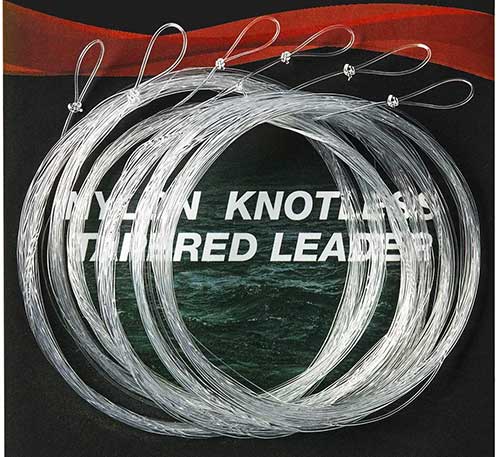
Buy from Amazon
Size
|
0x, 1x, 2x, 3x, 4x, 5x, 6x, 7x |
| Pound Test |
10.6, 9, 7.5, 6, 4.9, 3.7, 2.6, 1.8 |
| Color |
Clear |
| Length in Feet |
7.5, 9, 12 |
| Made in |
China |
Piscifun tapered leaders are quality and have pre-tied loops. A taped leader has heavier line on the loop end which gets thinner throughout the length of the line. This helps the line turn over the line and brings the fly to the end of the line. The loop on the end of the tapped leader is a perfection loop. If the knot breaks it is easy to re-tie if you know how to make a perfection loop.
The last two or three feet of the leader is the tippet section. The rated line weight is based on the tippet line strength. The tapered leader should be about the length of the fly rod. After tying on different flies the tippet lengths will get shorter. New tippet that is equal or smaller in line-diameter can be added to the tapered leader with a line to line connection. Good knots for this are the surgeon’s knot or double uni knot.
22. Fly Fishing Tippet
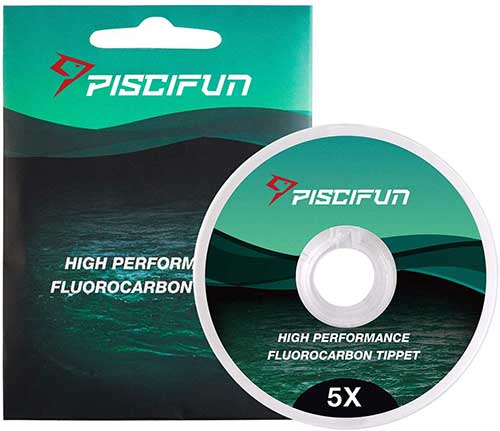
Buy from Amazon
| Size |
1x, 2x, 3x, 4x, 5x, 6x |
| Pound Test |
10, 8, 6.5, 5.5, 3.5, 3 |
| Color |
Clear |
| Length in Yards |
33 |
| Made in |
China |
Piscifun is high-performance fluorocarbon tippet material. The material for tippet is either a standard monofilament or fluorocarbon. Which tipped is best depends on the type of fly.
A monofilament tippet is better for dry flies as the line is not as heavy and keeps the fly floating more easily. A fluorocarbon tippet is better for bead flies nymphs that are fished beneath the surface. Fluorocarbon sinks and this can help the fly sink faster is moving currents.
A 1x tippet material is stronger than a 6x. This can confuse some people since a 1 wt fly rod is for very small fish and the higher the weight the stronger the rod, reel, and floating fly line will be. Just realize the tapped leader and tippet use a different size convention than the rod, reel, and floating line.
Lead core fishing line
A lead core fishing line has a dense lead core wrapped in a braided line or coated with nylon. The line is metered to allow the angler to know how much line has be let out without a line counter. Using a 27 or 36-pound line is a good idea because it is heavier and can get deeper with less line let out. Always add a 6-10 fluorocarbon or monofilament leader when using lead core.
Consider using a lead-core line if you want to set more lines at depths from 20-60 feet. There are various other ways to achieve the same goal. These ways include using downriggers, Monel or copper trolling wire, dipsey divers, jet divers, or a 6-ounce lead mooching weight on a flatline.
The primary advantage of lead core is it can get your lures deep without extra equipment. In my experience, about 2-3 colors (20-30 feet) of lead core will typically achieve around 10-15 feet of depth at normal trolling speeds. This varies based on speed, lure, and current though. I’ve had great success using lead core for salmon, walleye, and lake trout that suspend in the water column.
27. Sufix Best Lead Core Fishing Line Metered
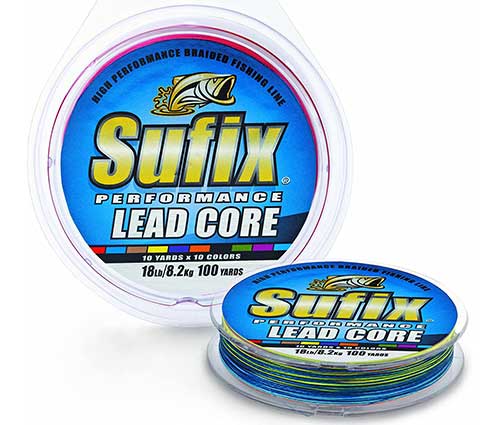
Shop Bass Pro Shops
| Pound Test |
12, 15, 18, 27, 36 |
| 27lb Diameter |
0.75 mm |
| 27lb Cost Per Yard |
$.18 |
| Color |
10 Colors Metered Line |
| Length in Yards |
100, 200, 600 |
| Made in |
China |
Sufix Performance is the best lead core fishing line. It has a heavy lead core with a braided fiber outer layer. A lead core line can either be coated with nylon or be made with a braided line.
A monofilament or fluorocarbon leader should be used when fishing with lead core line or wireline. Using a line to line connection or small swivel should allow the connection to through the eyes of the rod if a long 10-foot leader is used.
The depth the line will sink to depends on the boat speed, current speed, and type of lure being used. Common lures to troll with lead core are diving plugs and spoons. One way to determine depth is to troll in 20 feet of water and set line out until it taps the bottom. For an average spoon or lure letting out 20 feet of line gets the lure about 10 feet deep. So to get the lure 60 feet down about 120 feet of the line has to be set out. This line sinks deeper than running wire for a given amount line set out under most conditions.
The line is metered with 10 different color sections that change every 10 feet. This helps determine the amount of line set out which determines the depth of the lure. Using a line counter reel is the easiest wat to know how much line is off the reel. Line counter reels are commonly used for salmon and walleye fishing.
Monel trolling wire
Monel is a nickel-copper alloy wire that used when trolling to get lines deep. When running wire-line a twili-tip spring guide or roller guide needs to be installed on the tip of the rod or the wire will damage the top eye of the rod.
Fishing with wire is also commonly called trolling with copper. Monel is a slightly heavy line, more abrasion resistant, and more kink resistant than a cooper line. Monel is also thinner than a copper for any given strength. Fishing with Monel or copper is done the say way.
Monel and copper can be connected to swivels with a haywire twist or Palomar knot. Often times dacron is used as a backing line with wire-line setups. Dacron can be tied to the wire with an Albright knot. The knot should easily pass through the eyes of the fishing rod.
Fishing with wire allows baits and lures to be trolled up to about 60 feet deep without using a downrigger. It is common to use a 40-60 pound test wire. Every 30 feet of line let out gets the bait down about 10 feet. To get a bait 60 feet deep about 180 feet of wire needs to be set out. This method of trolling is done to catch salmon, steelhead, walleye, lake trout, and striped bass.
26. AFW Best Monel Trolling Wire Fishing Line
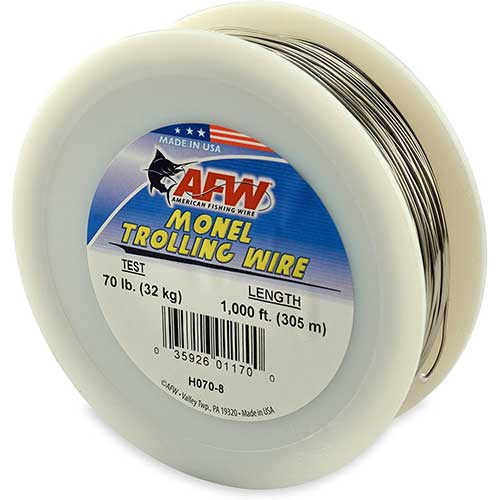
Buy from Amazon
Shop Bass Pro Shops
| Pound Test |
15, 20, 30, 40, 50, 66, 70, 88, 100 |
| 20lb Diameter |
0.46mm |
| 20lb Cost Per Yard |
$.24 |
| Color |
Silver |
| Length in Yards |
100, 200, 333 |
| Made in |
USA |
Monel is a nickel-copper alloy wire that used when trolling to get lines deep. When running wire-line a twili-tip spring guide or roller guide needs to be installed on the tip of the rod or the wire will damage the top eye of the rod. Bass Pros Shops has a similar soft stainless trolling wire that is made by Marlin.
Fishing with wire is also commonly called trolling with copper. Monel is a slightly heavy line, more abrasion resistant, and more kink resistant than a cooper line. Monel is also thinner than a copper for any given strength. Fishing with Monel or copper is done the say way. Blood Run copper trolling wire is popular because it is cheaper than Monel wire.
Monel and copper can be connected to swivels with a haywire twist or Palomar knot. Often times dacron is used as a backing line with wire-line setups. Dacron can be tied to the wire with an Albright knot. The knot should easily pass through the eyes of the fishing rod.
Fishing with wire allows baits and lures to be trolled up to about 60 feet deep without using a downrigger. It is common to use a 40-60 pound test wire. Every 30 feet of line let out gets the bait down about 10 feet. To get a bait 60 feet deep about 180 feet of wire needs to be set out. Typically 300-600 feet of wire is spooled on the reel. This method of trolling is done to catch salmon, steelhead, walleye, lake trout, and striped bass. Monel also works to secure anchor shackles.
Copper fishing line
Copper fishing line is a heavy wire than can get spoons and plugs deeper into the water. The typical target depth with copper wire is 20-60 feet. Copper wire is fished the same way as Monel or stainless steel trolling wire. Some anglers think the hum of the wire going through the water actually helps attract fish. Make sure a line counter fishing reel is used to know how much wire has been set out. In most cases though this copper line is used a rigging wire.
25. AFW Best Copper Rigging Wire
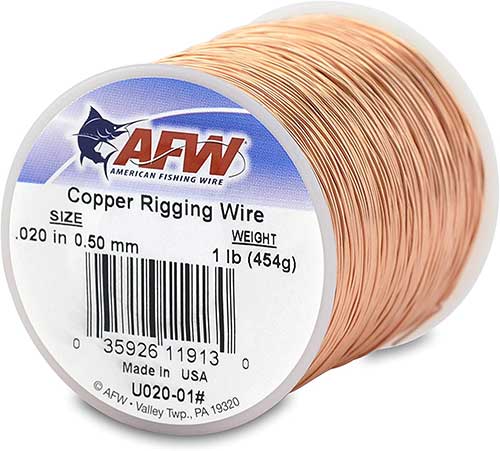
Buy from Amazon
Shop Bass Pro Shops
| Diameter |
0.50 mm |
| Cost Per Yard |
$0.083 |
| Color |
Copper |
| Length in Yards |
264 |
| Made in |
USA |
AFW rigging wire is used to secure a bait to a hook. Typically baits that are rigged with wire include ballyhoo, bonito strips, and chin-weighted mullet. An alternative to rigging wire is bait springs but many anglers prefer to rig baits with wire. Rigging wire is a type of line that is important to have on an offshore fishing boat, especially when fishing for mahi-mahi, marlin, and large tuna. Bass Pros Shops Offshore Angler has a similar type of rigging wire cut to 9-inch lengths.
This one-pound spool has about 792 feet of copper wire. AFW copper wire is also available in pre-cut 9-inch or 14-inch pieces. It is about 6 times cheaper to get the one-pound spool than the pre-cut length wire.
Ballyhoo are rigged with wire when trolling naked ballyhoo or skirted ballyhoo. The wire is wrapped around the head of the bait which if done properly allows the bait to be dragged in the water straight without spinning. Bonito strips are added to skirted baits such as metal-head stubby bubbler to add scent and flash to the bait. Rigging mullet with wire is done by adding a chin weight so to act as a keel to keep the bait running upright.
Dacron Fishing Line
Traditional thick braided linesare still used as backing material on large offshore reels and for situations where a softer, thicker line is preferred over modern thin braids.
Tuf-Line Dacron Fishing Line

Buy from Amazon
Shop Bass Pro Shops
| Pound Test |
20, 30, 40, 50, 80, 100, 130, 160, 180 |
| 20lb Diameter |
0.48 mm |
| 20lb Cost Per Yard |
$0.050 |
| Color |
Black, Green Spot |
| Length in Yards |
100, 300, 600, 1200 |
| Made in |
USA |
Tuf Line Dacron is the best Dacron fishing line. This was the most popular type of fishing line before the 1960s. Today braided fishing lines have been improved with new materials like Spectra, Dura, and micro-Dyneema. This has made the line much thinner for any given strength.
A thin light line is very important when casting. However, Dacron a thick braided line is still used today on conventional fishing reels. Mostly for a backing line to fill up large offshore fishing reels. Dacron is susceptible to line rot and UV damage where modern braided lines are not. It is a backing material and when it does not see light or water very often it can still last multiple seasons. This is why you will get mixed options on how long a Dacron line lasts. Some people say it rots quickly and others say it lasts for years. It really depends on how it is used. Some anglers also like a thick Dacron line because it does not cut into the skin as easily as a thin braided line when leadering fish.
Braided Nylon Gangion Line
Extremely thick, strong braided nylon designed specifically for halibut rigs and commercial fishing applications where scent detection is more important than line visibility.
Green Gangion Line
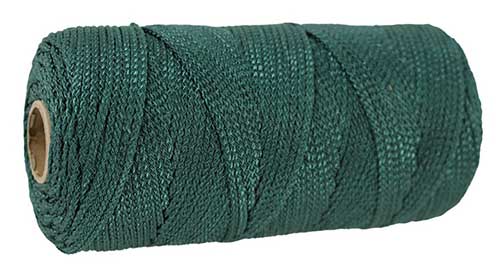
Buy from Amazon
Shop Bass Pro Shops
| Color |
Green, White. |
| Number 36 Diameter |
2.16 mm |
| Length in Yards |
171 |
A braided nylon twine is the best halibut leader material. This line in number 36 is good for making halibut leaders. The exact line I use for halibut leaders is Ashaway tuna leader, which is a solid braided nylon cord and is rated as a 150-pound test.
Halibut are not leader shy and mostly feed based on scent. For this reason, a thick braided line can be used. A short 100-plus-pound monofilament leader is still used to attach the hook. A heavy braided line is used to connect the hooks when commercial fishing for halibut using a halibut skate.
This line is great for making halibut fishing rigs. Halibut can also be caught with salmon mooching rigs with herring, swim jigs, vertical jigs, and pipe jigs. The best way to catch halibut though is to use fresh dead bait like pollack, herring, squid, or pink salmon.
Braid Monofilament Line Diameter Chart
The diameter of a fishing line is important because it determines how much fishing line a reel can hold. Reels often give the line capacity rating based on average monofilament line thickness. To determine how much-braided line the reel can hold the capacity of the equivalent braid-diameter should be used. For example, if the reel says it holds 150 yards of an 8-pound test it will hold about 150 yards of a 30-pound braided line. The diameter of the line is typically provided in mm or inches. Fluorocarbon line diameters are typically very similar but slightly smaller than a nylon monofilament line.

Common Questions About Fishing Lines
Can a fishing line be invisible?
No fishing line is actually invisible. Certain fishing lines reflect less light and depending on the color can blend into the surroundings to become much less visible. A thin fluorocarbon line is the best at reflecting less light since the index of refraction is closer to water. Colors for fluorocarbon and monofilament can be clear, green, smoke, red, gold, pink, and blue to best match the color of the water and surrounding environment.
Braided fishing line is thinner than monofilament but is still typically more visible. For this reason, a monofilament or fluorocarbon leader is typically used. If the proper color braided line used it can be much less visible in the water. White is a good color to use near the surface on bright days as it can blend into the sky. Dark green is a good color in low light and murky water conditions. Above water, it is best to have a visible line so anglers can see where the line is and prevent tangles.
What color fishing line should I use?
The best color fishing line is one that the fish can not see below water and the anglers can see above water. The best color depends on lighting and water conditions. Most anglers use a clear line for monofilament and fluorocarbon and moss green for braided line. These are good color choices but there are many other good color lines available. White braid and multi-color metered braided lines are also good options. Ultragreen is a popular monofilament color used in stained water.
Being able to see the fishing line above water is also important. There are lots of bright color lines such as high visibility yellow, neon, solar, white, and fluorescent orange that are easy to see above the water. Lead core line and metered braided lines have colors that change at set distances which allows anglers to estimate line depths.
What fishing line works for spinning reels?
The best fishing line for spinning reels for casting distance is braided fishing line. Monofilament line works well for casting up to a 30-pound test. Berkley Trilene XL smooth casting is the best monofilament line for spinning reels. It is soft flexible and has low memory which allows for far casting. Berkley Vanish is a good line for spinning reels when using a light 4-6 pound test line when trout and crappie fishing. Spinning reels come in various sizes so selecting a reel that holds enough line and has a proper drag rating for the size fish being targeted is important.
Is braid stronger than monofilament?
Braid is stronger than monofilament based on the thickness of the line. Also, braid can have a higher knot strength than monofilament especially when comparing the wet knot strength. Braided line is a static rope and does not stretch. In some ways this makes it stronger however the line does not absorb high impact shocks as well. A monofilament line can stretch rather than breaking from a strong fish head shake for example.
Is monofilament or fluorocarbon better?
In some cases, a monofilament fishing line is better and in other cases, a fluorocarbon line is better. As a leader material fluorocarbon is typically a better line as it is less visible and more abrasion resistant when wet. Fluorocarbon is more expensive and in some fishing situations, a monofilament leader is all that is needed. Also, some colors of monofilament like ultragreen or pink help make monofilament very low visibility in certain water conditions.
A fluorocarbon line is UV resistant has a self-life of around 7 years compared to a 2-3 year self-life of monofilament. As a mainline monofilament is typically softer and has less memory which is important when using spinning reels. For this reason, a fluorocarbon line is rarely used above 20 pounds. However, Berkley vanish does make fluorocarbon lines up to 40 pounds. This line can also be used as leader material.
What is high visibility line used for?
A high visibility line allows the angler to see the line above the water. This allows the lure or baits location to be determined by following the line into the water. When fighting fish sometimes lines get crossed and a high visibly line makes it easier to determine which rod should go over or under each other to not get tangled. Also being able the see the line helps give a better idea of how far back the lures are even when they are submerged underwater. There are also lines that show up well under a blacklight above the water and are good to use when night fishing.
How do you get rid of line memory?
Line memory is a fishing line staying the shape based on its previous position. If a fishing line is wound tightly on a round spool for even a few hours when the line comes off the spool it can be in the shape of coils. This is not a good thing and ideally, the line would have zero memory which is the case with a braided line. Stiff fluorocarbon and monofilament lines do have significant memory.
If the line memory is the shape of the reel spool it should not create tangles. If the memory is the shape of the spool the line came on it can create tangles. To avoid this the line should be placed tightly on the spool many hours before the line will be used. The spool-of-line can also be soaked in fresh-water for 20 minutes and then dried out to change the memory of the line to the spool. The thinner and softer the monofilament is the less memory it will typically have.
What type of fishing line is used for saltwater?
The best fishing line for saltwater depends on the type of fishing. A thin fluorocarbon line is best for small snappers, grunts, groupers, and porgies. A 30-pound monofilament line is great for inshore, reef, and offshore fishing on spinning reels. The leader matters should be thinner or larger based on the fish being targeted. For conventional reels, a 30-130 pound monofilament is a good option depending on the size of fish being targeted.
A braided line is very good option when fishing deep offshore. The line is thin and is affected less by ocean currents. Braided line also allows reels to hold significantly more fishing line. This allows for smaller lighter gear to be used which is great for stand up fishing.
What is the fishing line is easy to use with a baitcaster?
Baitcastiering reels are prominently used by bass fishermen. This means that both braid and monofilament are good lines to use depending on the type of lure. Heavy jigs can be easily pitched a short distance with braid or monofilament line. When casting for distance braided line is much easier to use because the line has no memory and is less likely to backlash. Experienced bass freshmen can use either type of line while beginners will have a much easier time using a braided line. The key to using a baitcasting reel is to always have finger control of the spool speed to prevent backlash and to control the lure’s speed for a soft landing.
Is the diameter of a fishing line important?
Yes, the diameter of a fishing line is important. The line visibility of fluorocarbon and monofilament is largely dependent on diameter. For this reason, a thin 6-pound test line will be much less visible to a fish than the same line with a 60-pound test. Some types of fluorocarbon are thinner than others for the same pound test so this should be compared when selecting a fishing line. In this article, I show the 20-pound line diameters in millimeters for this purpose.
Lines that are thinner and lighter will create less drag when casting a lure. This is why a thin braided fishing line can be cast super far. Thin monofilament lines also cast far. It is always surprising to me how far light lures cast when using a 4-pound test line for example. The diameter of the line also affects how-much line a reel can hold. Sometimes more of a lighter line is better than less of a heavy line. When using braid line capacity is rarely an issue and anglers tend to get line much stronger than is needed.
What fishing line floats?
Braided line floats, monofilament line sinks, and fluorocarbon line sinks fast. A floating line is actually very useful to use as a strike indicator. For example, I use a floating braided line as a strike indicator when bass fishing with soft plastics. The lure is cast out and then the bait sinks slowly for ten seconds. Extra line floats on top of the water and is slowly pulled down by the lure. Any change is speed means that the bait hit the bottom or that a bass bit the lure. In either case, it is time to quickly reel up the slack and set the hook if a fish is on the line. If the angler is not paying attention to the line the bass can spit the lure or swallow it and get gut hooked. This is why a floating braided line can be very important to use.
A floating braided line is also helpful to determine when a lure reaches the bottom. When jigging or dropping baits I tend to pull up slowly and down quickly to leave loose line on the surface of the water. This ensured that no extra drag is added to lure. When the floating line stops being pulled down it has reached to bottom or the bait has been taken by a fish.
How much fishing line is needed on a spinning reel?
It is common for a spinning reel to hold 150 years of fishing line. With most lures under one ounce, the furthest and angler can cast is about 40 yards. The remaining line is needed in the event that a fish pulls line off the reel after being hooked. A reel that is underfilled can cause extra drag as the line leaves the spool resulting in a decrease in casting distance. An overfilled spool can cause line to wrap around the rotor and get tangled during the cast.
As a spinning reel is used the line on the reel will get shorter as lures are changed or damaged line near the end is taken off. There is no set rule of how much line needs to be on a reel. When ice fishing, 50 years is typically enough. Reels used to fish in streams for trout typically hold 100 yards of line. A standard bass fishing reel holds around 150 yards of line and should never have less than 100 yards on the spool. For offshore saltwater reels, a typical 7500 size reel holds 220 yards of 30-pound line or 440 yards of 65-pound braid.
How much fishing line is needed on a conventional reel?
Conventional reels can be small level wind reels for bass fishing to large 130 class reels for catching 1000-pound marlin and bluefin tuna. Small conventional reels for freshwater trolling hold as little as 185 yards of 16-pound line on the Shimano Tekota 300. When salmon fishing a Tekota 600 is a great size reel and can hold about 300 yards of 30-pound monofilament.
A perfect size convention reel for saltwater trolling is a 30 class reel. It is small enough for stand up fishing and big enough to catch 200 plus pound fish. A 30 class reel can hold about 600 yards of 50-pound monofilament or 1435 yards of 80-pound braid. For deep dropping for daytime swords, it is common to use an 80 class reel with over 3,000 yards of 100-pound braided line. The largest 130 class conventional reels can hold 1300 yards of 100-pound monofilament or 4175 yards of 130-pound braided line.
What fishing line is most sensitive?
The most sensitive fishing line is a braided line. This line is static meaning that it does not stretch. The result is that all the force gets transferred to the rod. When using a braided line with a sensitive rod every little nibble can be felt through the handle of the rod. This provides significant information to the angler about what is going on with the bait.
The second most sensitive line is fluorocarbon. This line has less stretch than monofilament resulting in more of the energy being transferred to the rod. A monofilament line is the least sensitive but still transfers energy to the rod. When talking about sensitivity it is important to note that the line has to be under tension to feel bites. If the line is slack very little force from a bite will be transferred to the fishing rod.
Captain Cody has worked on charter fishing boats in the Florida Keys, Virgin Islands, and Alaska. Growing up in Pennsylvania Cody has also done extensive freshwater fishing including bass fishing tournaments. Cody strives to provide detailed information about the best fishing gear and tactics to help both novice and experienced anglers have a more productive and enjoyable time on the water. Cody also has a background in aerospace engineering and neuroscience but really only takes pride in being good at one thing and that is fishing!
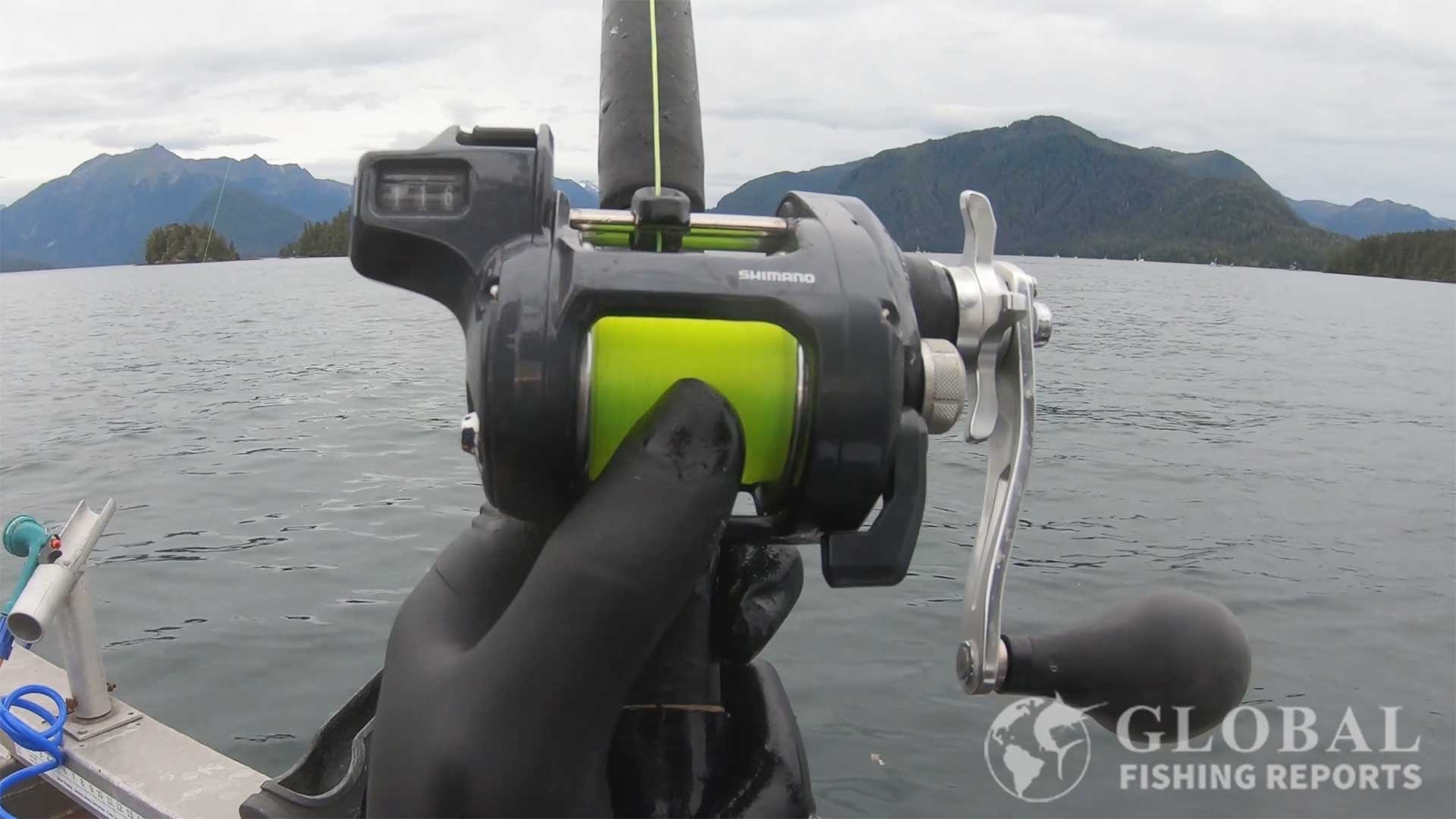
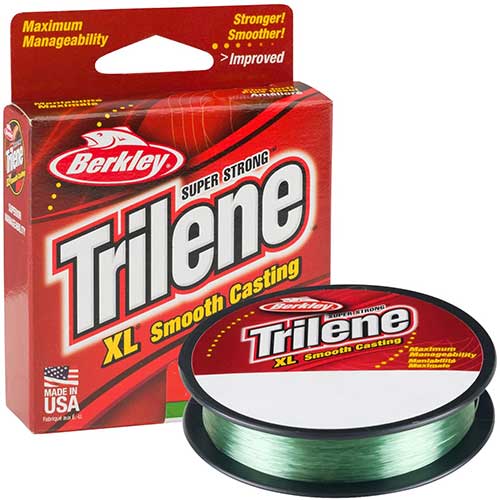
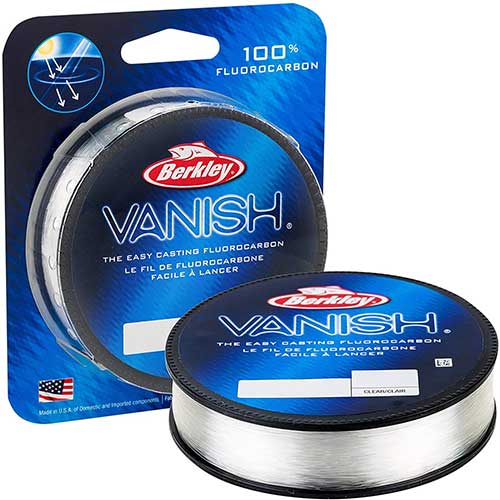


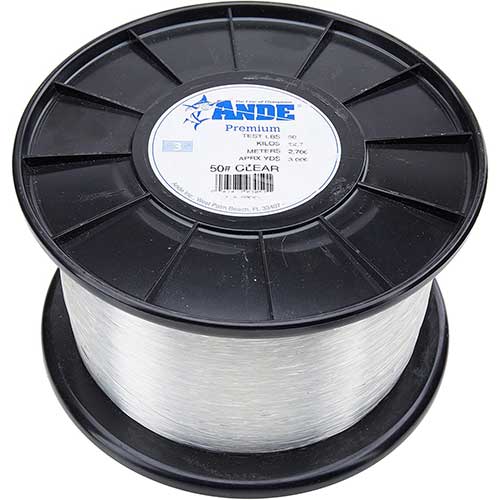
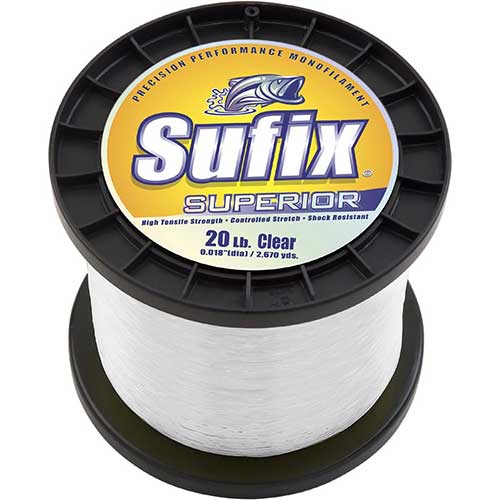
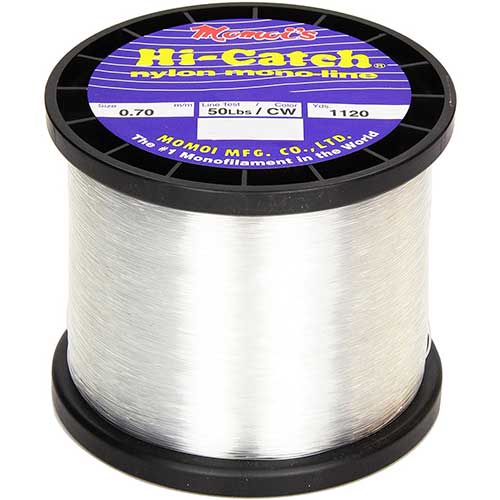
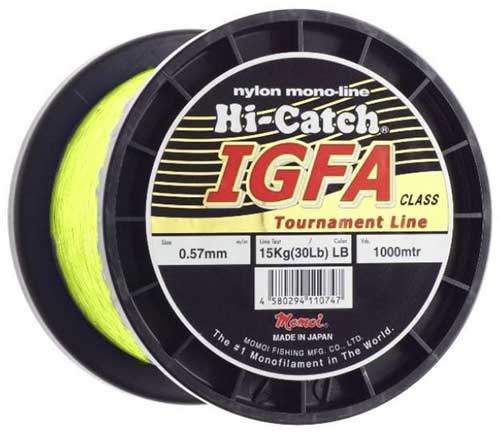



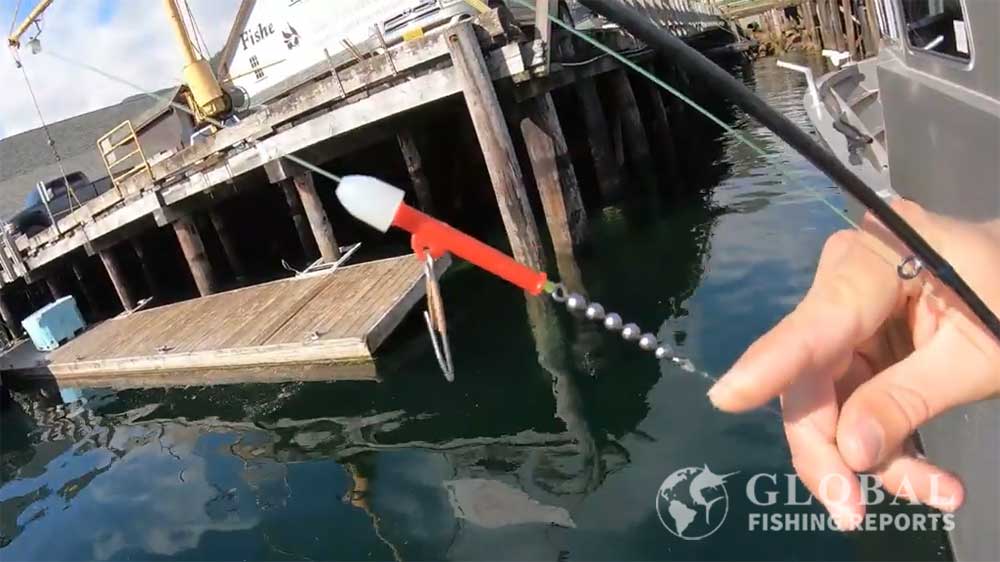




























I really enjoyed reading all your comments and instructions on fishing line and all the suggestions on the different types and how to install it and get the best results from it. But I watched your video on throwing a cast net twice back to back. I have three nets a 3/8, 7/8 and a 1″ mesh. One is a 7′ Bait Buster and two are Joy fish 6′. I’m not good but I’m getting better and I love the no teeth and not wearing it like a shirt. I like your video better than any I’ve watched and I’ve watched a lot. I’ve just about stopped bass fishing and started fishing for blue and flathead catfish. And getting bait is the hardest thing about catfishing. I live about five miles from Lake Guntersville Al. Big catfish and big bass live there. I just wanted to tell you how much I enjoyed your sharing of knowledge of what you do and love. May God bless you with many years of great fishing trips and great memories. Buddy Bright